Kuchi-e can be mentioned as a special field that works as a place of interaction between the ukiyo-e-shi and modern Japanese painters in the latter part of the Meiji period and as a place for new activity by e-shi (paint artist), hori-shi (who carve woodblock) and suri-shi (who print) in the decline period of ukiyo-e. In around Meiji 20th, the modern literatures that expressed the humanities or customs of the people who lived at the time vividly were born. They were different from the graffiti that were based on the ideas or moral from the Edo period. And they were also different from the political novels or translation novels that were published from the beginning of the Meiji period. They were published a lot by letterpress printing but the beautiful picture inserted on the first page was the kuchi-e that was created by woodblock print. Kuchi-e was attached greater importance to be said that no kuchi-e no sales and was very popular for about 30 years from the beginning of the modern literature to the beginning of the Taishō period.
The bright colored kuchi-e that was firstly looked by the readers affects the image of the background or the main characters of the story and was very important for the writer also. The kuchi-e that was created to aim for melt away from graffiti and fit to modern literatures did not have the flavor of the ukiyo-e that was in premodern style and did not fit to the time. Then the artists who gained fame as Japanese-style painter or the ukiyo-e-shi, such as Mizuno Toshikata, whose style was mainly based on Japanese-style painting were selected as e-shi for kuchi-e. And good pairs such as Ozaki Koyō and Takeuchi Keishū or Izumi Kyōka and Kaburaki Kiyokata were born.
- Kawai Gyokudō
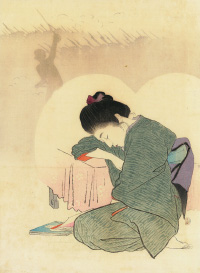
"Bungeikurabu Dai Jū-nana kan Nana gō"
Meiji 37th (1904) - Kubota Beisen
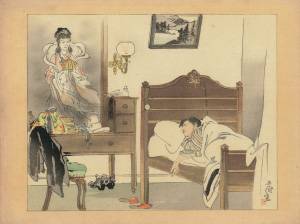
"Ōunabara"
Meiji 27th (1894) - Tsutsui Toshimine
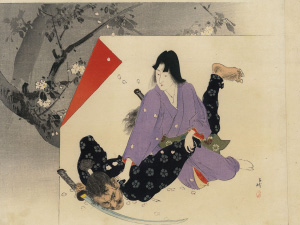
"Yari Hitosuji"
Meiji 33rd (1900)
Different from the illustration for newspaper novel that was printed by a woodblock inserted in letterpress printer, kuchi-e was created by bright multiple colors that needed the skills of not only hori-shi but also suri-shi. On the other hand, different from the ukiyo-e that e-shi drew outline only and designated colors by characters, kuchi-e was printed based on the samples that firstly had outline and secondly hand-colored for each color. By this change of creating process, actually by more detailed changes, the painters who had never taken part in ukiyo-e became to be able to do it. (For example, when creating ukiyo-e, e-shi needed a relationship with suri-shi because they designated colors by characters and there are many colors mentioned by one word, for example, "red" can means dark red, light red, bright red or so on.) But at the same time, the degree of freedom given to hori-shi or suri-shi became to be decreased. The technique of hori-shi and suri-shi had reached its peak at that time. But the technique was used to reproduce the painter's lines or colors faithfully rather than producing dynamic art collaboration with techniques and spirits of three of them, e-shi, hori-shi and suri-shi in the work of ukiyo-e.
- Bibliography:
Yamada Nanako. Masterpieces: Collection of Kuchi-e Prints and Their Stories. Tokyo: Bunsei Shoin, 2006.
Yamada Nanako. A Survey of Woodblock Kuchi-e Prints. Tokyo: Bunsei Shoin, 2005.
- Watanabe Seitei Kaei 4th - Taishō 7th (1851-1918)Open or Close
At the age of sixteen he became a disciple of Kikuchi Yōsai and became independent after hard practices. In Meiji 11th, he became the first international student in France as a Japanese painter. He was strongly influenced by Shibata Zeshin (though he never studied under him) and very good at kachō-ga (print/drawing of flowers, birds or living things except human being). He got many awards on exhibitions in and outside Japan. He didn't have any pupils but Mizuno Toshikata studied under him. He denied the invitation to Nihon Bijutu In from Okakura Tenshin. He won fame on hand-drawing, gahu (book of paintings), kuchi-e and so on.
-
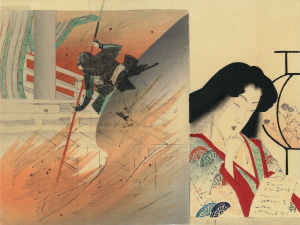
"Yasuda Sakubē"
Meiji 27th (1894)
-
-
Mishima Shōsō Ansei 3rd - Shōwa 3rd (1856-1928)
Open or Close
Among the pupils of Kikuchi Yōsai, he had particularly outstanding ability. By the recommendation of Ernest Fenollosa, he participated in Kanga-kai. Although he was ordered to be a teacher in Tokyo Bijutu Gakkō (means, Tokyo art school), he placed a distance from art schools or exhibitions and never had a pupils. Mizuno Toshikata studied Japanese-style drawing under him.
-

"Bungei-kurabu Dai-9-kan 11-go Mushino-ne"
Meiji 36th (1903) -
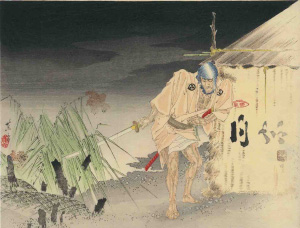
"Meiji-bunko Nana-hen Niwaka-chōja"
Meiji 27th (1894)
-
-
Suzuki Kason Man-en 1st - Taishō 8th (1860-1919)
Open or Close
At the age of 14, Kason became a pupil of Nakajima Kyōsai who was the best pupil of Kikuchi Yōsai. After that he became a member of Kanga-kai and got prizes on many exhibitions. He also participated in the establishment of Nihonga-kai. As a kuchi-e artist, he was one of pioneers just like Watanabe Sitei or Mishima Shōsō and leads the followers such as Terasaki Kōgyo, Kajita Hanko or Tomioka Eisen. He drew kucih-e for English books and was the most well-known kuchi-e artist in foreign countries.
-
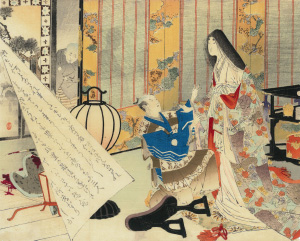
"Kiri-hito-ha"
Meiji 29th (1896) -
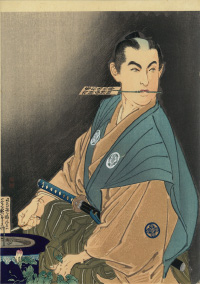
"Kurui-zaki"
Meiji 36th (1903)
-
-
Kajita Hanko Meiji 3rd - Taishō 6th (1870-1917)
Open or Close
It is said that he studied under Yōshu Chikanobu when he was young for a short period, but he mainly studied by himself using "Zenken Kojitu" created by Kikuchi Yōsai because of the recommendation by Suzuki Kason who he was strongly influenced by. He was one of the initiator of the establishment of Nihon Seinen Kaiga Kyōkai. He was an ardent admirer of Okakura Tenshin and became a special supporting member of Nihon Bijutu In. He played an active parts in kuchi-e or the illustration on newspaper. Later in life, he educated Kobayashi Kokei, Maeda Seison or Okumura Togyū who were the representatives of painting circles.
-
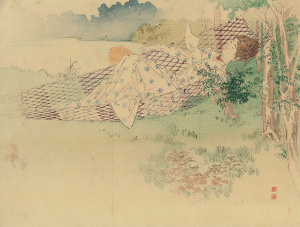
"Bungei-kurabu Dai-6-kan 9-hen Karato-yama"
Meiji 33rd (1900) -
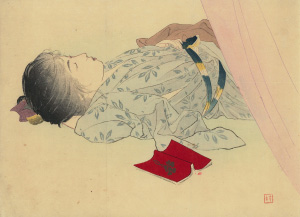
"Bungei-kurabu Utatane"
Meiji 39th (1906)
-
-
Kobori Tomoto Genji 1st - Shōwa 6th (1864-1931)
Open or Close
Upon winning the award of Kyōshinkai, he studied Japanese-style painting. He participated in Nihon Seinen Kaiga Kyōkai and Nihon Kaiga Kyōkai. Recognized by Okakura Tenshin, He became the assistant professor of Tokyo Bijutu Gakkō, the first member of Nihon Bijutu In or the judge of Monbushō Bijutu Tenrankai. He made a great contribution to the Japanese painting circle. He put efforts to researching "Yūsoku Kojitu" and was good at rekishi-ga (historical print/drawing). Yasuda Yukihiko who is a master of rekishi-ga is one of his pupils.
-
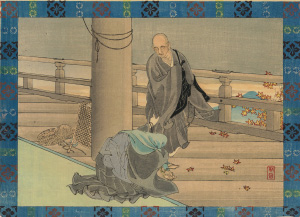
"Bungei-kurabu Dai-4-kan 2-hen Saigyō Tsuma ni Au"
Meiji 31st (1898) -
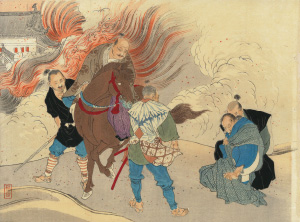
"Kiku to Kiri"
Meiji 31st (1898)
-
-
Terasaki Kōgyo Keiō 2nd - Taishō 8th (1866-1919)
Open or Close
At the age of fourteen, he studied in Kanō party and after that, he studied Nan-ga in Shijō party. He played an active part in drawing Hon-ga, reproduction of old paintings, illustration or so on. He also played an active part in Nihon Seinen Kaiga Kyōkai and Nihon Kaiga Kyōkai. Recognized by Okakura Tenshin, He became an assistant professor of Tokyo Bijutu Gakkō, the member of Nihon Bijutu In, the judge of Monbushō Bijutu Tenrankai and so on. He opened the biggest private school in Tokyo and educated many Japanese-style painters.
-
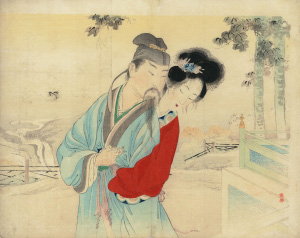
"Nichiyō Hyakka Zensho Sakushi Jizai"
Meiji 29th (1896) -
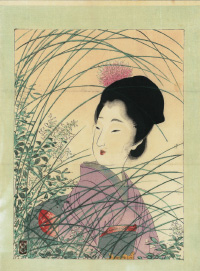
"Nichiyō Hyakka Zensho Nichijō-kōi no Hōsoku"
Meiji 32nd (1899)
-
-
Takeuchi Keishū Bunkyū 1st - Shōwa 18th (1861-1943)
Open or Close
He became a pupil of Kanō party and Tukioka Yoshitoshi but be said that he studied drawing almost by himself. He created many illustration kuchi-e as an employee of Ken-yūsha and the combination with Ozaki Kōyō gained popularity. He played a role as the chef of drawing section about "Bungei-kurabu" in Hakubunkan from Meiji 28th. He played a leading role as a kuchi-e paint specialist on both of quality and quantity.
-
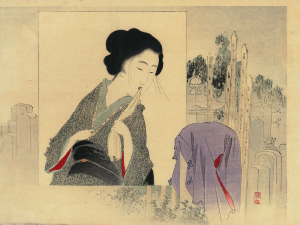
"Bungei-kurabu Dai-5-kan 14-hen Hutari Yamome"
Meiji 32nd (1899) -
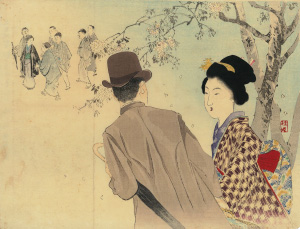
"Bungei-kurabu Dai-4-kan 10-pen I-kō Sen-ei"
Meiji 31st (1898)
-
-
Tomioka Eisen Genji 1st - Meiji 38th (1864-1905)
Open or Close
At the age of eighteen, he became a pupil of Kobayashi Eitaku in Kanō party. He played an active part in Nihon Seinen Kaiga Kyōkai or Nihongakai as a Japanese-style painter. He participated in Nihon Bijutu In that was established by Okakura Tenshin as a special supporting member. He was good at bijin-ga (print/drawing of beautiful women) , hūzoku-ga (print/drawing of custom) and musha-e (print/drawing of warrior). He became popular by "Hūzoku Gahō", "Bungei-kurabu", illustrations on newspaper or kuchi-e. He educated younger kuchi-e painters positively.
-
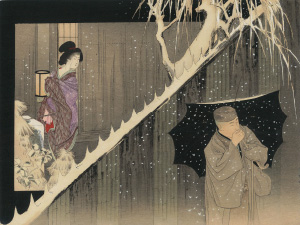
"Kokoro no Yami"
Meiji 27th (1894) -
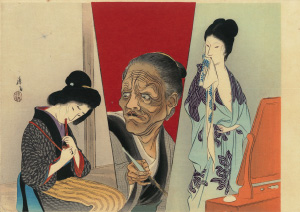
"Rangiku Monogatari"
Meiji 35th (1902)
-
-
Mizuno Toshikata Keiō 2nd - Meiji 41st (1866-1908)
Open or Close
As the first pupil of Tsukioka Yoshitoshi, he created many illustrations on "Yamato Shinbun" (Yamato Newspaper) with Yoshitoshi. He played an active part in both ukiyo-e and Japanese-style drawing. He participated in Nihon Seinen Kaiga Kyōkai and Nihon Kaiga Kyōkai. He became a supporting member of Nihon Bijutu In when it was established. He established Rekishi Hūzoku Gakai with Kobori Tomoto in Meiji 35. He studied kachō-ga and so on under Watanabe Seitei and Mishima Shōsō. He is one of a leading person who played an active part in kuchi-e or on "Bungei kurabu". He educated many painters such as Kaburaki Kiyokata or Ikeda Terukata.
-
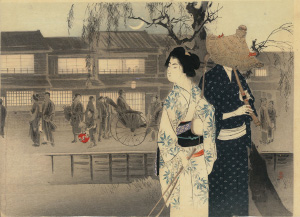
"Renbo Nagashi"
Meiji 33rd (1900) -

"Shunka Shūtō Dai-2-hen Natu Yūsuzumi"
Meiji 27th (1894)
-
-
Kaburaki Kiyokata Meiji 11th - Shōwa 47th (1878-1972)
Open or Close
At the age of thirteen, he became a pupil of Mizuno Toshikata. After that, he created illustrations for "Yamato Shinbun" that was managed by his father Jōno Saigiku and Toshikata also created illustrations for. Especially the combination with Izumi Kyōka became very popular and he created many bijin-kuchi-e on "Bungei Kurabu". He established Ugō-kai with the pupils of Tsukioka Yoshitoshi, Mizuno Toshikata and Ogata Gekkō in Meiji 34th and pursued the hūzoku-ga that utilize the traditional of ukiyo-e. He got great success as a Japanese-style painter but he attached greater importance to the paintings that can be enjoyed at hand until his later years. He had many pupils of Japanese-style painters or print artists such as Ito Shinsui, Kawase Hasui or Terashima Shimei.
-
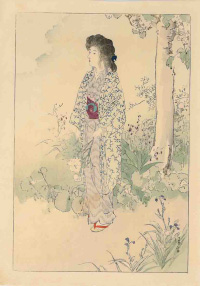
"Bungei-kurabu Dai-11-kan 7-go Sozoro Aruki"
Meiji 38th (1905) -
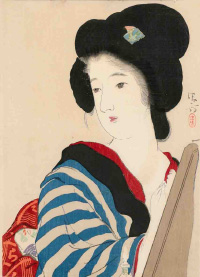
'Bungei-kurabu 20-kan 4-go'
"Tumabeni"
Taishō 3rd (1914) -
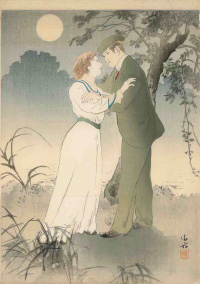
"Hichū no Hi Zenpen"
Taishō 2nd (1913)
-
